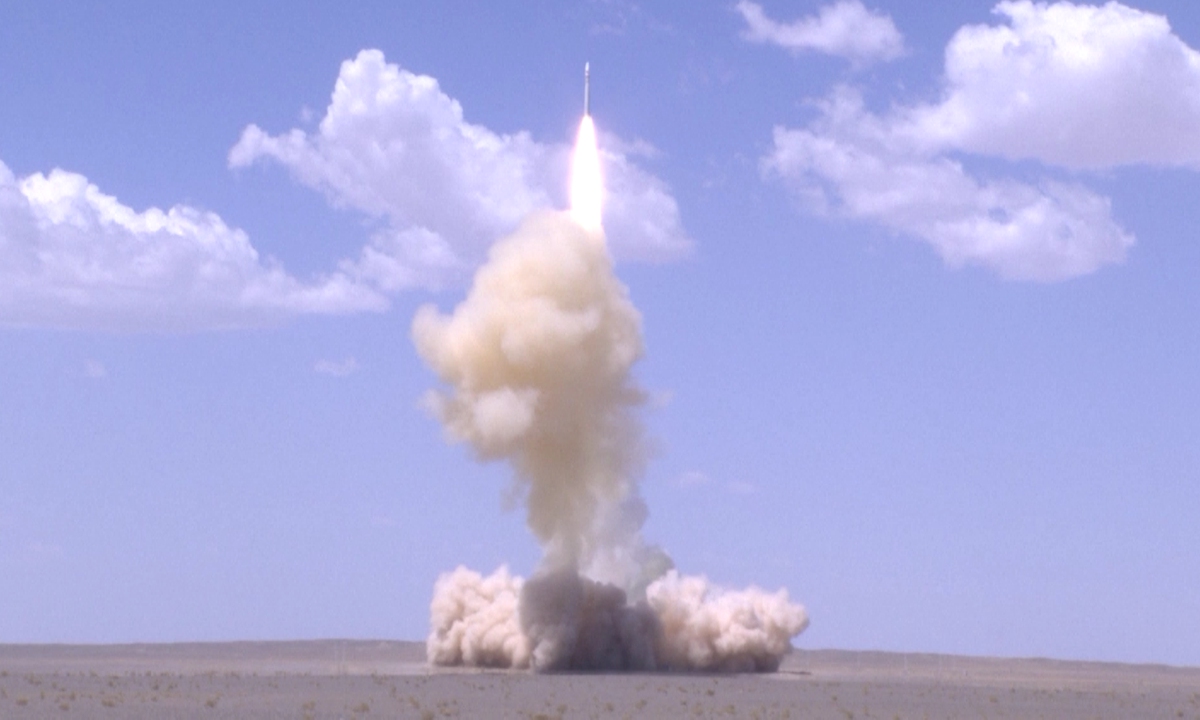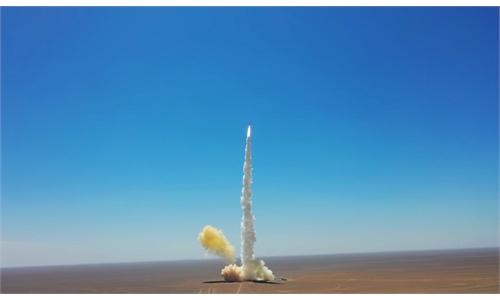Exclusive: From reusable rockets to space travel, Chinese commercial rocket developer eyes innovation

China's Lijian-1 (ZK-1) solid propellant rocket makes its maiden flight from the Jiuquan Satellite Launch Center on July 27, 2022, successfully sending six satellites into their preset orbits. Photo: CFP
On July 27, China's largest solid propellant rocket - Lijian-1 (ZK-1) - made its maiden flight from the Jiuquan Satellite Launch Center in Northwest China, successfully sending six satellites into the 500-kilometer Sun-synchronous orbits (SSO). Against the background that foreign commercial rockets can realize satellite constellation network through a single launch, the successful maiden flight of ZK-1 with a capacity of 1.5 tons in the SSO is undoubtedly of great significance. Prior to that, the capacity of Chinese commercial space rockets in SSO was below 1 ton. Apart from a boost in load capacity, ZK-1 has made a series of technical breakthroughs in rapid response, precise orbit entry and unsupported launch, which further expanded the country's space emergency launch capability and provided more possibilities for the development of China's solid launch vehicle technology.
Usually, it takes 5-10 years for a solid rocket model to develop to its maiden flight, but the ZK-1 rocket took just over 3 years from the official launch of the project in 2019 to the successful flight in July 2022. The vehicle was developed by the Chinese Academy of Sciences and the Guangzhou Zhongke Aerospace Exploration Technology Co (CAS Space).
In an exclusive interview with the Global Times, deputy chief engineer of the rocket Shi Xiaoning said the record-breaking speed was the result of an innovative approach based on China's mature aerospace industry.
Compared with liquid rockets, solid launch vehicles have simpler systems and high engine reliability, making them more cost-effective for commercial companies. Most of the domestic commercial space rockets are solid propellant, including the ZK-1.
Different from previous designs, the ZK-1 has eliminated subsystems of the rockets and achieved flat management. The overall design process upheld the concept of intelligence, integration, generalization and modularization in the selection of mature products for system integration to ensure quality control and reliable performance.
For the next step, CAS Space will continue to enrich the spectrum of China's solid propellant launch vehicles. In addition to building a sea launch platform for ZK-1, a new solid rocket with a diameter of 3.5 meters is also under development, the Global Times has learned.
According to Shi, this solid rocket will be benchmarked against Europe's 3.4-meter-diameter Vega-C rocket, with an engine capable of carrying payload of more than 2 tons to the SSO.
The project team is also planning to add three more solid propellers on the basis of ZK-1, further enhancing the capacity on top of the existing model, which is also expected to become the launch vehicle for China's space station cargo spacecraft in the future.
Multiple breakthroughs
Compared with liquid rockets, the significant advantages of solid rockets lie in their fast response and non-dependent launch capability, while the disadvantage lies in the inability to turn on and off their engines multiple times, and the difficulty in controlling the accuracy of orbit entry.
On ZK-1, however, the advantages of solid rockets have been retained while the disadvantages are effectively improved after multiple technical breakthroughs.
One of the breakthroughs is the fast response capability of ZK-1. The rocket would obtain launch condition in merely seven days of preparation at technical plant, and five hours after transfer to the launch site.
In an interview with the Global Times, Hu Xiaowei, deputy chief engineer of launch support for ZK-1, said that rockets of the same kind overseas are usually assembled and tested in the assembly workshop and then transferred vertically to the launch pad, or assembled and tested on site at the launch pad, which need a longer preparation period.
While for ZK-1, a research team has made a ground-breaking innovation in the technique for rising up the vehicle vertically, allowing it to be erected quickly after horizontal transfer to the launch pad. According to Hu, the system can not only support the erection of 135-ton-weighing rocket, but even 160 to 170 tons.
Such a technology innovation will greatly expand the application scenarios of large-tonnage solid launch vehicles, Hu said.
Another breakthrough for ZK-1 is in the high precision of orbit entry. The final measured half-length axis of the satellite's orbit of ZK-1's maiden flight was only 500 meters away from the target orbit.
In the eyes of Lian Jie, deputy chief designer of the flight control of ZK-1, a solid rocket is like a "cannonball" whose orbit entry is extremely difficult to control. "To ensure precise orbiting, the safety and reliability of the rocket control system were improved through proactive strategies, while giving the rocket the ability to fly intelligently and control the distribution of energy," Lian told the Global Times.
In order to achieve precise orbiting even when the solid rocket runs out of power, ZK-1 innovatively applied the technology of two-stage energy management, allowing the rocket to make autonomous maneuvers like "space dancing." This ensures that the rocket runs out of energy when it enters the predetermined orbit, thus achieving the effect of high-precision orbiting, Lian said.
Eyeing reusable rockets
For commercial space companies, technology iteration, cost reduction and efficiency enhancement are eternal issues. In order to achieve this goal, the research and development of liquid rockets with high reliability and low cost advantages, especially those with reusable capability, is imperative. Reusable rockets are also crucial to developing space travel, and this cutting-edge technology is also the focus of the next breakthrough by the CAS Space team.
The key to the mastery of this technology is the algorithm, including the verification of engine's variable thrust capability and multi-start capability, experts said.
This May, CAS Space completed a liquid oxygen kerosene rocket engine assessment, laying a solid foundation for the reusable technology. The engine has 60 to 100 percent thrust adjustment capability and three starts, which can be used as the main power for rockets and suborbital vehicles to meet reusability requirements.
After having mastered mature reusable technology, CAS Space will launch a publicly accessible suborbital space travel vehicle. The vehicle will use a combination of single-stage rocket and a travel capsule, allowing a single flight of seven tourists for a 10-minute flight. Passengers will cross the 100-kilometer Kármán line, experience 3 minutes of weightlessness free from gravity, and finally land safely by parachute.
The space travel vehicle will be able to be reused for over 30 times, with a single ticket price of about 2 to 3 million yuan ($277,600 to $416,400) for a single person.

